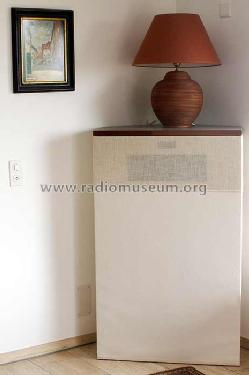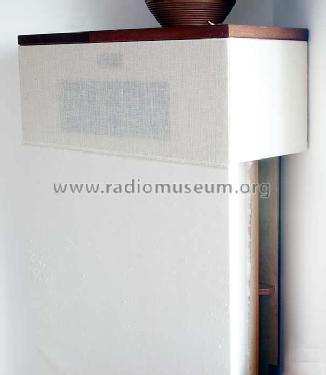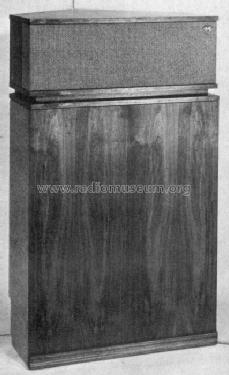Klipschorn E (C style, not Klipschhorn) K-347?
Klipsch Audio Technologies; USA
- Country
- United States of America (USA)
- Manufacturer / Brand
- Klipsch Audio Technologies; USA
- Year
- 1947 ??

- Category
- Loudspeaker, headphone or earphone
- Radiomuseum.org ID
- 92306
- Power type and voltage
- No Power needed
- Material
- Wooden case
- from Radiomuseum.org
- Model: Klipschorn E K-347? - Klipsch Audio Technologies;
- Dimensions (WHD)
- 28.2 x 52 x 28.2 inch / 716 x 1321 x 716 mm
- Notes
-
Floor standing, fully horn-loaded, very high efficient, three-way speaker system. The Bass section is a folded-horn structure utilizing adjacent walls as horn extension. Response 23 to 17'000 Hz within 5 dB. 400 and 6000Hz crossover frequencies. 16 ohms impedance. Several finishes available. A 'classic' speaker system, one of the very best, in production for years and years.
Sensitivity: 104 dB SPL, one watt / one meter.
Klipschorn E: the E stands for Europe or Export, KC-BR stands for Klipschorn C style (no collar between the top and bottom section) — Birch Raw (unfinished Birch wood).
- Author
- Model page created by Ernst Erb. See "Data change" for further contributors.
- Other Models
-
Here you find 9 models, 7 with images and 0 with schematics for wireless sets etc. In French: TSF for Télégraphie sans fil.
All listed radios etc. from Klipsch Audio Technologies; USA
Collections
The model Klipschorn E (C style, not Klipschhorn) is part of the collections of the following members.
Forum contributions about this model: Klipsch Audio: Klipschorn E K-347?
Threads: 3 | Posts: 4
Hier einige Angaben aus Verkaufsunterlagen auf deutsch:
Dreiwege-Hornlautsprecher
- Versteiftes Gehäuse aus MDF (Medium-Density-Fiber) mit zweifach gefaltetem Tieftonhorn
- Legendäre Eckhornkonstruktion für impulsschnelle, kompressionsfreie Tieftonwiedergabe. Eine dritte Faltung des Tieftonhorns wird durch Aufstellen in Ecken erreicht
- Außergewöhnlich verzerrungsarme, extrem dynamische Hoch- und Mitteltonwiedergabe durch den Einsatz von Druckkammerlautsprechern mit angesetztem Horn
- Unkritisches Lastverhalten und extremen Wirkungsgrad
Technische Daten
|
Persönliche Bemerkungen:
Erstaunlich ist vor allem der Wirkungsgrad von 104 dB bei 1 Watt und Abstand 1 Meter (Standardmessung) - den maximalen Schalldruck würde ich nicht empfehlen ;-)
Vor allem esoterische HiFi-Freaks würden allerdings müde den Kopf schütteln, dass man so etwas altes betreiben kann, denn die "mechanische Verstärkung" durch ein Horn (Trichterlautsprecher, Grammophone - und vorher) ist natürlich sehr alt. Noch vor den Hörrohren (bei Taubheit) hat man das Prinzip bei der Tonerzeugung angewendet.
Tatsache ist jedoch, dass die Hörer ganz erstaunt sind über die Transparenz und Präsenz der Musik. Man kann das Klipschhorn direkt ab einem Kopfhörerausgang eines MP3-Players verwenden - und muss bei Gesprächen die Lautstärke am Player zurück drehen ...
Ernst Erb, 06.Aug.07
When I posted my first Forum entry on Klipsch speaker systems, I was just relying on my memories. From the late sixties to the early seventies I owned several models, Heresy, Cornwall, La Scala and evaluated the Belle and the Klipschorn; eventually I retained a couple of La Scala, which still today are my favorite speaker enclosures. Recently I have found data about the Klipsch production of that time in some Hi-Fi magazines, including a 1972 Stereo Directory and Buying Guide. Then I loaded new entries to cover the five base models built at the time by Klipsch.
But the incomparable sound of a couple of Klipsch enclosures, when reproducing the vibrating notes of a grand piano or the loud bass of a pipe organ, cannot be described in few words of notes to the model. I remember that the Klipsch dealer also distributed top speakers from well-known manufacturers: Electro Voice, Altec, JBL, Harman Kardon, Empire. Well, after having enjoyed the deep, vibrating organ sound in the introduction of 'Also sprach Zarathustra' coming out from a couple of Cornwall or of Belle Klipsch, any other speaker appeared as sounding flat and colorless.
In the past I read several technical articles from Paul W. Klipsch. Unfortunately I lost them and today I can just rely upon the Radiotron Designer's Handbook for information about the horn loudspeakers. Two major sources of distortion in standard speaker systems are the non-linearity of the magnetic flux linked with the voice coil over its travel and the reduced compliance of the cone suspension, when large displacements from the rest position are reached. Klipsch found that the distortion could be dramatically reduced, limiting the displacement of the moving coil and of the cone or, in other words, using horn speakers. Horns act as sound amplifiers: a relatively small vibration of the driving unit at the throat of the horn gives a loud sound coming out from its mouth. Moreover the horn speakers have very high efficiency, when compared with any other enclosures: few watts of electrical power give a full orchestra in a room, with plenty of power reservoir for handling any super-imposed bass drum beat. To give the same sound pressure level an infinite baffle could require up to one hundred times more electrical power: amplifier and speakers may be driven well into saturation!
The horn principle was not new, but Paul Klipsch committed his life to design and build the most perfect speaker systems ever made, based upon horn units all over their bandwidth. The first Klipschorn production dates back to 1946 and the model is still built today, over than sixty years later, with only minor changes. The Klipschorn, with its nearly flat response down to about 30Hz and its very high efficiency, about 50%, is the most perfect speaker system ever built for home. Klipschorn uses a 15 inches speaker as driver for the bass horn; the sound is radiated from the enclosure toward two perpendicular walls of the room, integral parts of the horn itself.
Around 1963, Paul Klipsch introduced a fully self-contained horn enclosure, La Scala, which could be placed anywhere in the room, not just in a corner. Few years later Klipsch introduced the Belle, a finished version of La Scala. Both La Scala and the Belle used the same speaker set of the Klipschorn, giving a similar efficiency and slightly reduced response at very low frequencies.
Of course two Klipschorn enclosures were not intended for small flats. Large halls with three walls and two corners free from obstacles were required to host them, as remarked by Klipsch in the following advertising, "You already own important parts of a fine stereo system: your room corners":
forumdata/users/6435/klipsch/adva.jpg
Also La Scala and the Belle asked for large rooms, due to their radiation pattern. Unfortunately, in some large halls the two speakers could be too far from each other, giving a poor stereo effect in the middle: in this case a central speaker could be very desirable. Here is the reason why Paul Klipsch decided to build first the Heresy and later the Cornwall enclosures. Heresy was an infinite baffle enclosure and the name itself denotes the repulsion of the designer for such a low efficiency solution. Cornwall was a tuned duct port enclosure with fairly high efficiency, using the same speaker set of the Klipschorn: one 15 inches woofer, one horn loaded mid-range and one horn tweeter.
Here is another advertising of Klipschorn, first appeared in 1969 and still published in 1974. The text, signed by Paul Klipsch himself, says that the advertising had been already true in five years and will be true in another five years. How bad prophet he was: the same advertising is still true today, over than thirty years later!
forumdata/users/6435/klipsch/advb.jpg
It would be nice if someone can add more information about the evolution of the Klipsch production in the years, i.e. when and why the impedance was scaled down from 16 to 8 ohms. Also interesting can be the technical articles written by Paul W. Klipsch.
Attachments
- Advertising A (197 KB)
- Advertising B (195 KB)
Emilio Ciardiello, 23.Jul.07
Klipschorn and La Scala were two different models built by Paul Klipsch. The main difference, apart their dimensions and their price, was that the Klipschorn used the walls of the room as integral part of the bass horn unit, while in the La Scala, which was the unfinished version of the Belle Klipsch, the bass horn was self contained.
Two Klipschorn speaker units required a custom designed house, to host them: two corners and three walls of solid concrete, free from obstacles. The basses were radiated toward the walls and here reflected to the room center.
The Belle Klipsch, and the unfinished La Scala, had wooden walls on the sides, so to complete the folded horn driver in the cabinet itself and the basses are radiated to the front.
In the late sixties, both the Klipschorn and the Belle Klipsch, or La Scala, had 16 ohm impedance, to reduce the influence of long wires.
At the time Klipsch also produced two more models: Cornwall, which was a 50W bass reflex, and Heresy, the name was self explicatory, a small 25W infinite baffle.
Here is a picture of the La Scala
Emilio Ciardiello, 25.Mar.07






